How to include more people in the Nordic labour markets?
If every Nordic country learned from each other’s successes, 700 000 more people could be in work, according to Danish researchers Sarah Kildahl Nielsen and Vibeke Jakobsen.
How is workplace integration going in the Nordic labour markets?
“None of the Nordic countries stands out as being particularly good at including vulnerable groups into the labour market,” says Sarah Kildahl Nielsen, project leader at HBS Economics.
All of the Nordic countries are more or less struggling to include young people, seniors, immigrants, people with handicaps and people with mental health issues. Employment levels among these groups are lower than for the general working-age population.
As the first part of a major research project financed by the Nordic Council of Ministers, VIVE and HBS Economics in Denmark have analysed these vulnerable groups in the Nordic labour markets.
Project leader Sarah Kildahl Nielsen from HBS Economics and senior researcher Vibeke Jakobsen presented the first results during the Nordic Council of Ministers conference on 15 November in Oslo.
The results focused on outsiders in the Nordic countries, the need for measures aimed at increasing work participation and which obstacles vulnerable groups meet in the Nordic labour market.
The conference was a cooperation between the Nordic Council of Ministers, the Ministry of Labour and Social Inclusion and NAV – the Labour and Welfare Administration.
Do what the best do
Sarah Kildahl Nielsen from HBS Economics believes the Nordic countries can learn a lot from each other in terms of including vulnerable groups in the labour market. One country might have found good measures for how to get more young people into working life while another has been more successful in including more people with handicaps in the labour market.
The Danish researchers made the point that the Nordic countries must learn from and make use of measures that work. Because if all of the countries “only” manage to reach the same employment levels as the best, the researchers have calculated this would mean an extra 700 000 people in work.
It would see employment levels in the Nordic countries increase by 6% for people aged 15 to 64. It has increased by 2% in the past ten years.
“If everyone learns from the best in class, the potential increase in employment levels is big,” said Nielsen.
Sweden focuses on education
If we stay with this idea and look at immigrants as a group, the Nordic countries’ aim should be to increase employment levels to 79% for this group. 79% of immigrants in Sweden are in work, while the figure is 73% in Denmark and Finland and 74% in Norway.
The Nordic average is 76%, 9% lower than the average number of the general employable population.
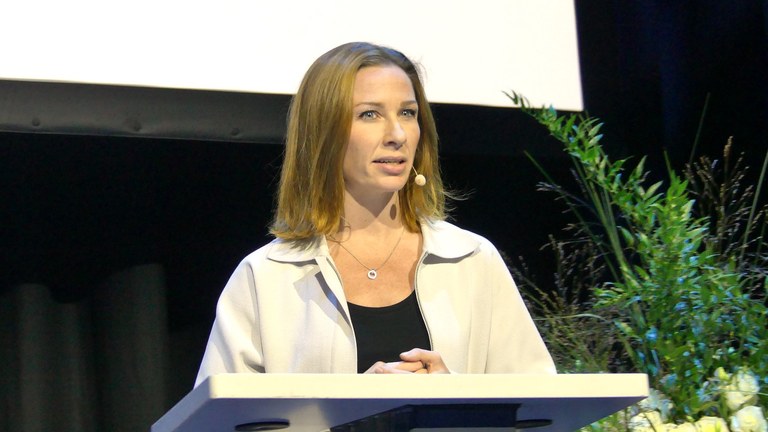
Vilde Hernes from NIBR, OsloMet, did not declare a winner when asking the question: Which Scandinavian country is best at integrating refugees in the labour market?
So what are the Swedes doing better than the other countries?
“Sweden is more successful because they focus more on education and are better at using the skills refugees bring with them from their home country,” said senior researcher Vilde Hernes at the Norwegian Institute for Urban and Regional Research at OsloMet.
She has worked with Swedish and Danish colleagues to try to find out which of the three countries has been most successful at integrating refugees into the labour market. They have followed the same refugees over a 10-year period, first between 2008 and 2016, and then for a further three years until the end of 2019.
“Refugees to Denmark find jobs faster, but in the longer run, more refugees get jobs in Sweden than in Denmark. Norway is the clear winner when it comes to integrating female refugees,” the researchers told the Nordic Labour Journal in 2019.
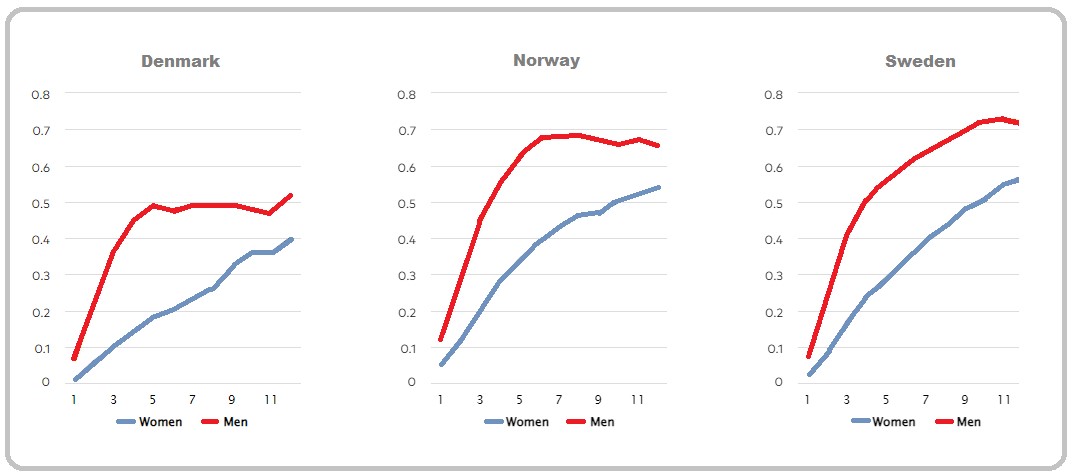
Prognosis for how employment levels develop in the three Scandinavian countries shows that both men and women do better in Denmark and that refugees in Sweden get a bit higher than in Norway – but at a later stage. Source: NIBR. The graphs are slightly edited by NLJ..
Hernes presented some of the results at the conference.
The Swedes are improving
Norway, Sweden and Denmark all have comprehensive integration programmes for refugees. They have a shared aim – to help refugees into the labour market so that they can become economically independent.
But the Scandinavian countries have chosen different paths when it comes to integration measures.
The researchers’ mapping shows that Denmark mostly uses work experience and less education, while Norway’s main focus is on elementary-level education and the Swedes go for higher-level education and wage support.
So which measures produce the best results? Which country gets the most refugees into the labour market? According to Hernes, it is difficult to identify a Scandinavian champion. All of the countries can learn something from each other.
What they have seen is that Norway achieves better results after three to four years. But while the Danes lag behind all the way, the Swedes are catching up with Norway.
“After ten years, Sweden is level with Norway and the countries have a nearly identical number of immigrants in the labour market,” explained Hernes.
Education measures for refugees seem to have little effect on work participation in the short term. In the longer term, however, education measures have a big effect on participation in the labour market.
Refugees in Sweden are generally more likely to take further education. This in turn leads to higher work participation and the refugees end up higher on the wage statistics.
When to invest?
In other words, everything points to the fact importance of investing in education in order to get refugees into work in their new home countries. The question is at what point do you invest? Should it happen relatively soon after the refugees have arrived in a country, or do you wait and see whether they move on to a third country or return home?
“There is a great chance that refugees stay in the county they arrive in,” said Hernes, who points to former periods of refugee influx as well as the current one from Ukraine.
Hernes believes Norway must prepare for the fact that many of the Ukrainians will remain in Norway also when the war is over, and that the authorities should therefore take this into account when preparing integration measures.
In June, the NIBR researchers carried out a survey among nearly 700 Ukrainian refugees. The report is made on commission from the Norwegian Directorate of Immigration (UDI) and the Directorate of Integration and Diversity (IMDi).
The refugees were asked whether they believed their stay in Norway will be long-term, and more than one in four answered yes, they thought they would stay in Norway. Ukrainians want to participate in the introduction programme and learn Norwegian, and they want to work or study in Norway.
“This is a challenge for integration policies also in terms of how to include them into working life. Do we have a short-term or long-term perspective for what we are doing? This is a difficult choice, but our study indicates that it is risky not to invest in Ukrainians’ future in Norway,” said Hernes.
The workplace as arena
Many of the Ukrainians who have arrived in Norway have higher education, but the question is whether they have the skills which are needed in the Norwegian labour market. This is not unique for refugees from Ukraine but a general challenge for many of the vulnerable groups in the labour market.
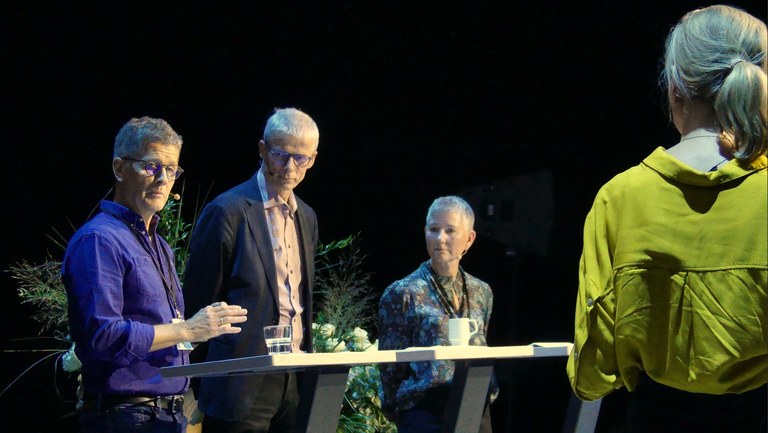
Høgni í Stórustuvu from the Faroese Employment Service, Hans Christian Holte, head of NAV and Maria Kindahl, AF, Sweden, during a panel debate moderated by Marianne Marthinsen.
One of the questions asked during the Nordic conference was whether inclusion could be the solution to mismatching in the labour market. In a time of severe labour shortages, there should be ample opportunities for including more people, pointed out Hans Christian Holte, head of NAV.
In Norway, there were 76 600 applicants for 37 300 positions in October – around two applicants for every position. The challenge is the imbalance that exists between the skills which employers seek and the skills applicants can offer.
“We must find out more about what is needed in terms of education and skills, and we must also use the workplace as an arena for learning to a greater extent than before,” said Holte.
He participated in a talk on the inclusion of vulnerable groups in Nordic labour markets, alongside Maria Kindahl from the Swedish Public Employment Service and Høgni i Storustovu from the Faroese Employment Service. The Nordic colleagues underlined the importance of learning from each other.
“Every measure we have now we’ve already stolen from our Nordic colleagues,” said Høgni i Storustovu with a glint in his eye.
Although conditions are considerably smaller in the Faroe Islands, their challenges are the same as elsewhere in the Nordics. Yet unlike his colleagues from Sweden and Norway, Høgni could say that he knows everyone who is outside of the labour market in the Faroe Islands.
“Today they are 28 individuals,” he smiled and added more seriously:
“One of our jobs is to break the social isolation for those who over long periods of time fail to find a job.”
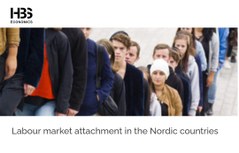
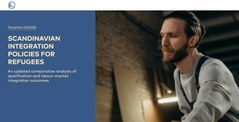
 Follow us on Facebook
Follow us on Facebook
